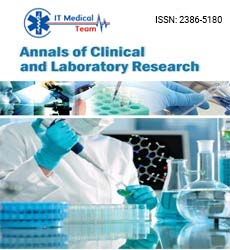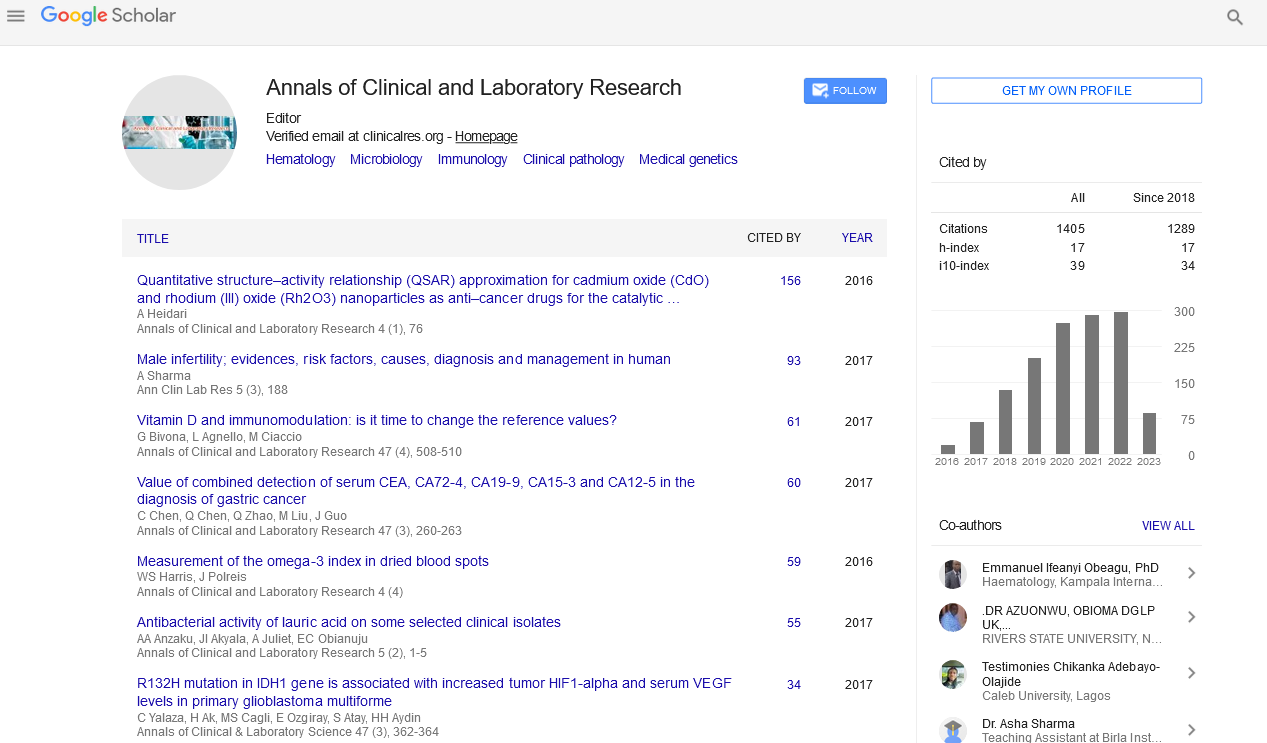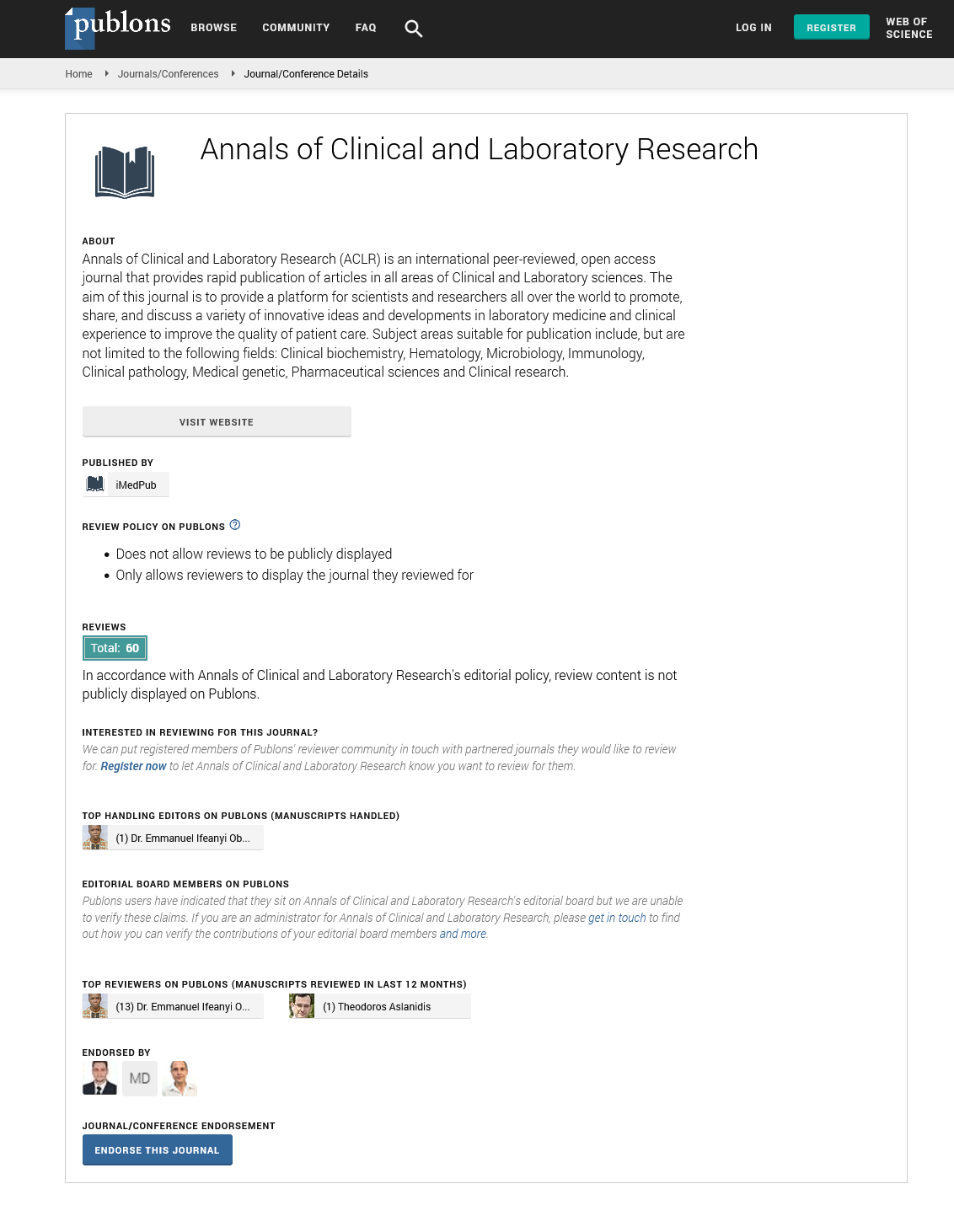Perspective - (2025) Volume 13, Issue 1
Diagnostic Evaluation of Rheumatoid Arthritis
Fabian Welch*
Department of Rheumatology, Aureus University School of Medicine, Aureus, Aruba
*Correspondence:
Fabian Welch, Department of Rheumatology, Aureus University School of Medicine, Aureus,
Aruba,
Email:
Received: 23-Oct-2023, Manuscript No. IPACLR-23-14123;
Editor assigned: 26-Oct-2023, Pre QC No. IPACLR-23-14123 (PQ);
Reviewed: 09-Nov-2023, QC No. IPACLR-23-14123;
Revised: 19-Feb-2025, Manuscript No. IPACLR-23-14123 (R);
Published:
26-Feb-2025
Introduction
Rheumatoid Arthritis (RA) is a chronic autoimmune disorder primarily affecting the joints. The diagnosis of RA relies on a combination of clinical assessment, medical history, and various laboratory and imaging techniques.
The diagnostic procedures and tests employed in the evaluation of Rheumatoid Arthritis (RA). RA is an autoimmune disease characterized by joint inflammation and pain, necessitating a multi-faceted diagnostic approach.
Diagnostic procedures
• Gathering comprehensive medical history, with a focus on joint related symptoms and familial autoimmune disease. Performing a physical examination to assess joint swelling, tenderness, and deformities, contributing to diagnostic insights.
• Detection of RF, an antibody present in the blood of some RA patients. Note that RF positivity is not exclusive to RA.
• Measurement of anti-CCP antibodies, which are highly specific to RA as they target citrulline found in affected joint synovium. Present in a substantial percentage of RA patients.
• Analysis of white blood cell count and hemoglobin levels. Elevations may suggest RA related inflammation.
• Assessment of these inflammatory markers in the blood. Elevated levels indicate ongoing inflammation, common in RA.
• Utilization of X-rays, ultrasound, and Magnetic Resonance Imaging (MRI) to visualize joint damage and assess disease progression.
• Aspiration and analysis of joint fluid to identify inflammation and the presence of crystals, aiding differential diagnosis.
• Scintigraphy or Positron Emission Tomography (PET) scans to evaluate joint inflammation and damage.
• Identification of genetic markers, such as gene, which can increase the risk of RA development.
• Application of the 2010 ACR/EULAR classification criteria, considering joint involvement, laboratory results, and symptom duration.
Description
Rheumatoid Arthritis (RA) presents a complex challenge for diagnosis due to its multifactorial nature and variability in presentation. The primary symptoms-joint pain, stiffness, and swelling-often overlap with other conditions, making clinical assessment crucial. A thorough medical history is essential to differentiate RA from other forms of arthritis, as family history and symptom duration can provide significant diagnostic clues.
Laboratory tests play a pivotal role in confirming RA. The presence of specific autoantibodies, such as Rheumatoid Factor (RF) and Anti-Citrullinated Protein Antibodies (ACPAs), can support a diagnosis, although not all patients test positive for these markers. Additionally, inflammatory markers like C Reactive Protein (CRP) and Erythrocyte Sedimentation Rate (ESR) can indicate the level of systemic inflammation, aiding in both diagnosis and monitoring disease activity.
Imaging techniques, including X-rays and ultrasound, provide visual evidence of joint damage and inflammation. X-rays can reveal characteristic changes over time, such as erosion and joint space narrowing, while ultrasound can detect synovitis even before it manifests clinically. This comprehensive approach-integrating clinical evaluation, laboratory tests, and imaging-ensures a more accurate diagnosis, essential for initiating timely and effective treatment.
Furthermore, early diagnosis of RA is critical, as it can significantly influence disease progression and overall patient outcomes. Delays can lead to irreversible joint damage and increased disability. As such, ongoing research into more sensitive biomarkers and advanced imaging modalities continues to enhance diagnostic accuracy, ultimately improving management strategies for those affected by this debilitating condition. The integration of these various diagnostic tools reflects the complexity of RA and underscores the necessity for a tailored approach in clinical practice.
Conclusion
In conclusion, the diagnosis of Rheumatoid Arthritis (RA) requires a comprehensive and multifaceted approach due to its complex nature. By integrating clinical assessments, detailed medical histories, and advanced laboratory and imaging techniques, healthcare providers can accurately identify RA and distinguish it from other conditions. Early and precise diagnosis is crucial for effective intervention, which can significantly improve patient outcomes and quality of life. As research continues to evolve, the refinement of diagnostic tools promises to enhance our understanding and management of this challenging autoimmune disorder.
Citation: Welch F (2025) Diagnostic Evaluation of Rheumatoid Arthritis. Ann Clin Lab Res Vol:13 No:1






